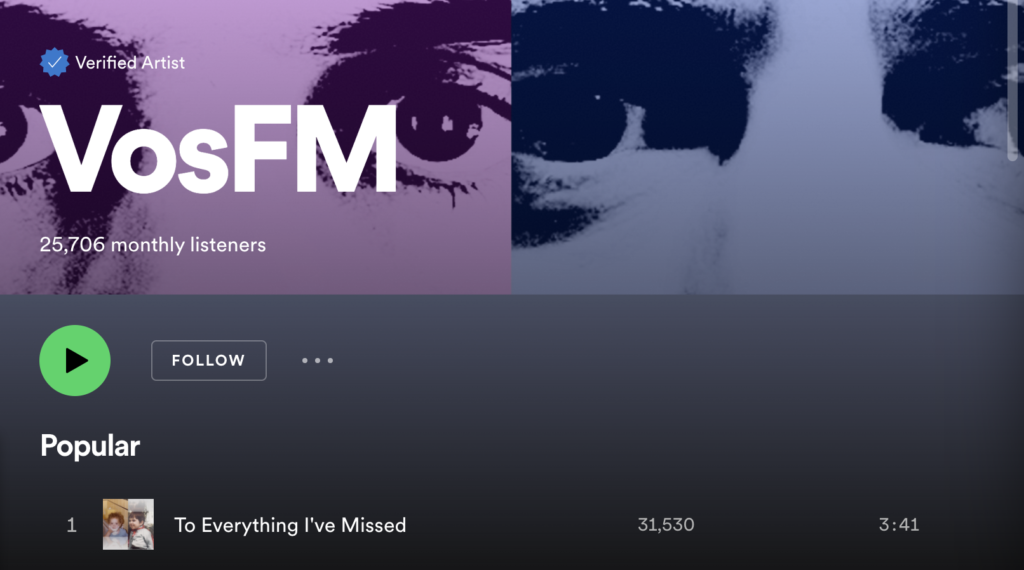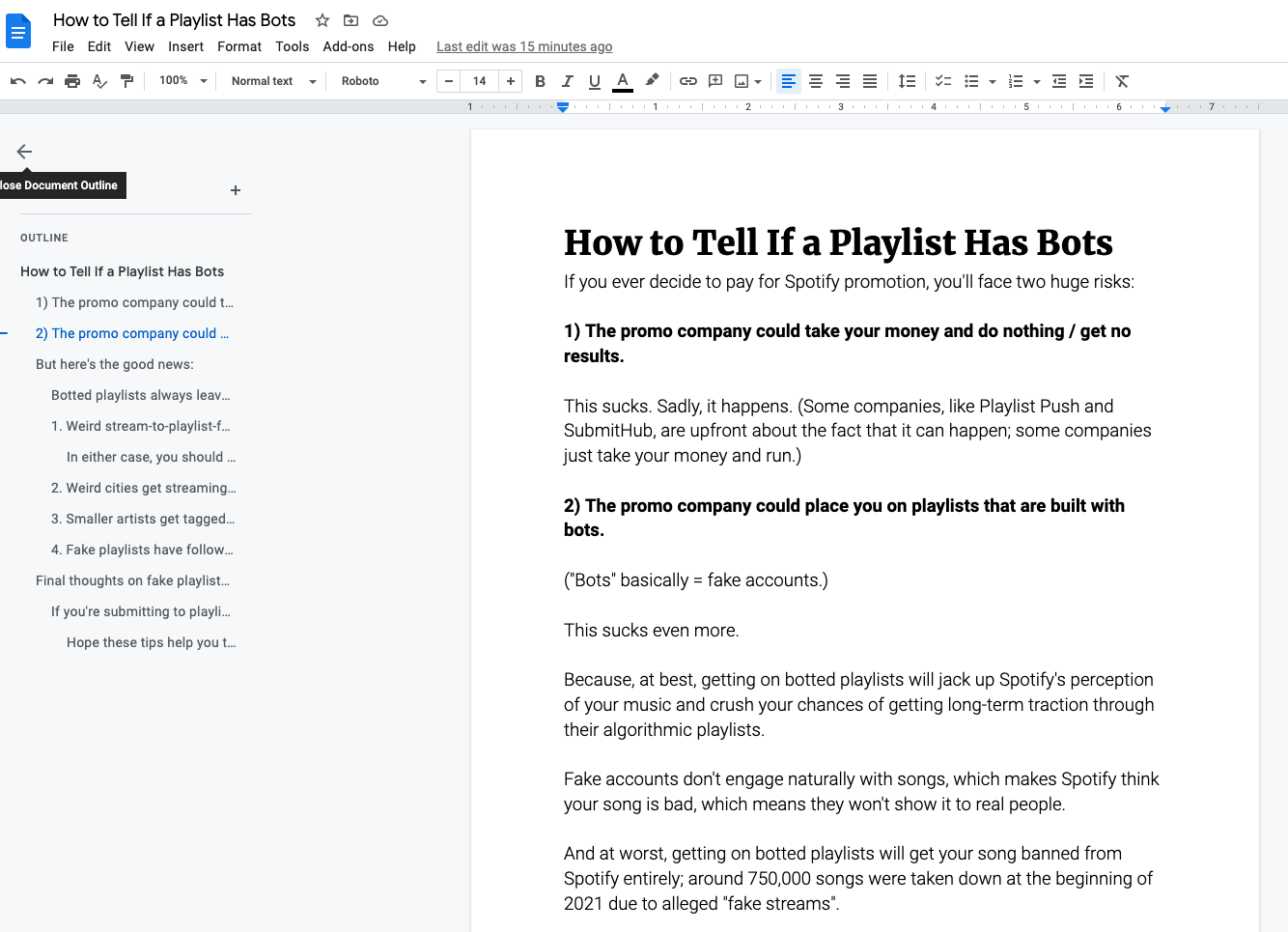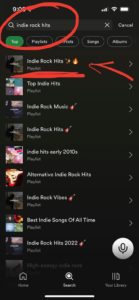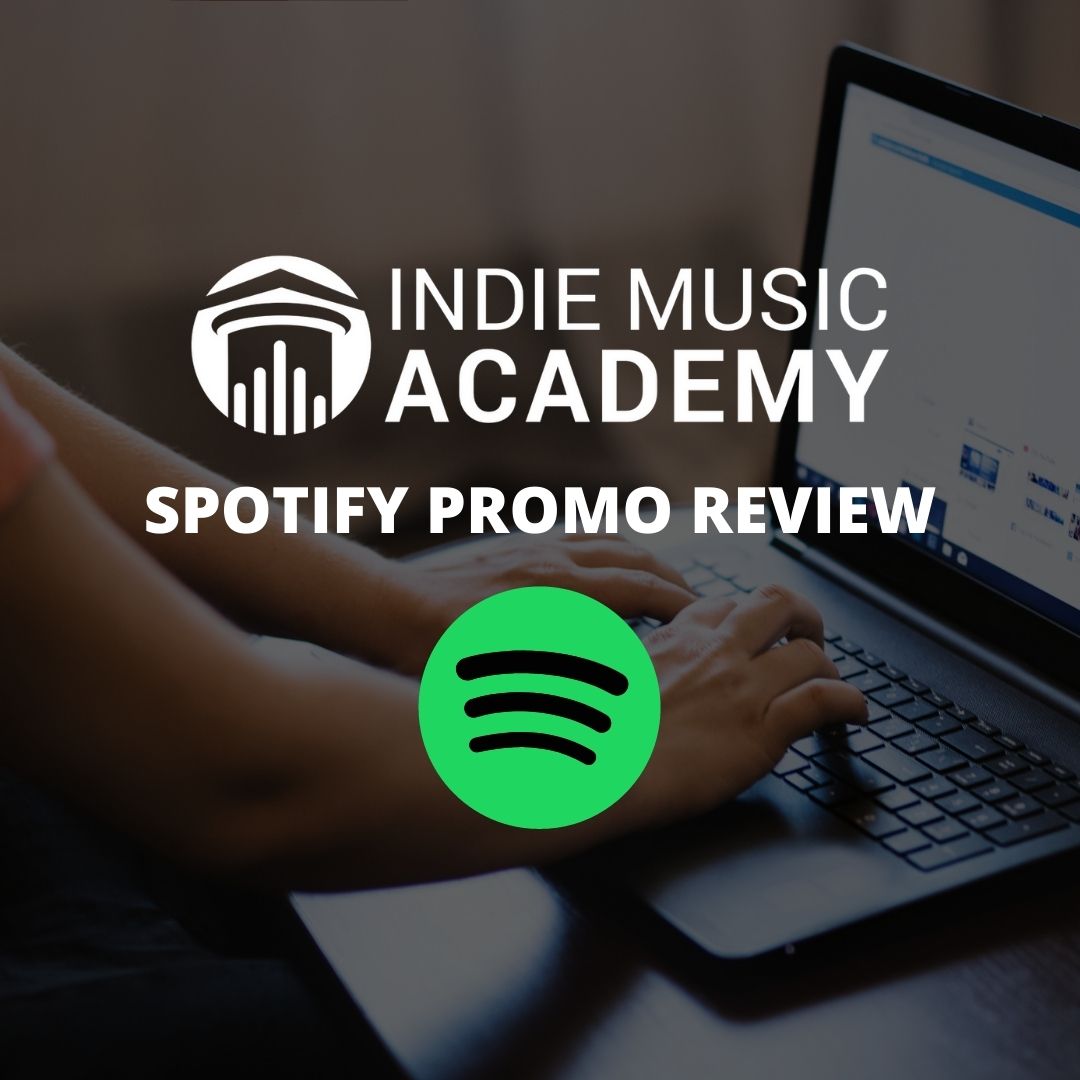So, you’re here because you’re wondering…
Is Indie Music Academy’s Spotify promotion service legit?
Fair question. Here’s my quick answer: Yes, it’s legit.
In fact, it’s my top Spotify promotion company for 2024 (out of about a dozen that I’ve tried).
The backstory: I run Two Story Media, a PR firm focused on helping indie artists get heard and understood. To help one of my clients build a Spotify presence, we reached out to the team over at Indie Music Academy, and they offered to let us try their service for free in exchange for writing this review. From what we found, they do use legitimate promo techniques to generate legitimate streams. I’ll get into the details / results shortly.
Now, this doesn’t mean that Indie Music Academy’s offer is the best promo option for every artist. It doesn’t even mean that their team will always be able to get great results (more on that shortly, too). But it does mean that they’re legit.
And from what I’ve found, they legitimately offer artists a great opportunity for driving meaningful Spotify growth.
If you want to give the service a try, click here.
Disclosure: That’s an affiliate link. Related disclosure: I’m proud to be an affiliate with Indie Music Academy because, again, they’re legit.
Okay, that’s the quick answer and the high-level view. But if you’re reading this article, you’re probably considering dropping a few hundred bucks on the IMA team, which means you’re probably looking for a little bit more info to make sure you’re not sending that money down the drain.
Good call. You absolutely should do your research before spending on Spotify promotion.
So, let’s get into the weeds.
I’ll start by covering what my experience using Indie Music Academy was like. Then, based on conversations I’ve had with Ryan Waczek (the founder over at IMA), I’ll discuss some of the machinery behind the curtain.
Hopefully, by the end of this article, you’ll have a solid understanding of how Indie Music Academy’s Spotify promotion works – and a better understanding of whether it can work for you.
My results with Indie Music Academy’s Spotify promotion
Good news: My Spotify campaign with Indie Music Academy worked.
Here’s what happened:
- Timeline: It took about three weeks from first contact to final placement
- Process: Manual communication (there’s not a platform, like with SubmitHub or Playlist Push)
- Cost: We got a free trial, but our package would’ve been $537
- Placements: Three playlists
- Results: 31,000 streams in the first month (and counting) with 25,000 monthly listeners
I ran a mid-level campaign with the IMA team for one of my clients. As I mentioned, Ryan let me trial this for free; if you were to pay for it, you’d currently be looking at $537 for the 20,000 Guaranteed Real Streams option on the product landing page. The song we worked on was “To Everything I’ve Missed“, the debut track from indie synth-rock group VosFM.
Thanks almost entirely to Indie Music Academy’s promotion, the track notched tens of thousands of streams in a little over a month.
We tallied placements on three third-party Spotify playlists: “Indie Rock Hits”, “Indie Rock Music”, and “Tik Tok Music”.
Here’s where the track stands as of this writing:

It started with less than 1,000 streams; now, it’s at over 31,000, and we expect it to keep rising.
It’s important to note that, from what we can see, these are real streams.
One sign (among many) that the streams are real is visible in that image above; it’s the gap between streams of the track and VosFM’s monthly listeners.
If all of those streams came from, say, 5,000 monthly listeners, it’d mean that a few accounts were re-streaming the track over and over, which would be unrealistic user behavior and a likely sign of bots. But if, on the other hand, those streams were from 31,000 monthly listeners, it’d mean that virtually nobody was listening to the track multiple times (also a likely sign of bots and an awful signal to send to Spotify).
As things stand, that gap signifies real user behavior from real people who streamed the track. It’s clear that many people discovered the track on a playlist and only streamed it once. But it’s also clear that some people streamed it multiple times. Again, this is a sign of real user behavior. It’s also a signal for Spotify’s algorithm that the track has legs – when users engage with a track, Spotify gathers data on who those users are, then uses that data to show the track to other similar users.
Bottom line: This makes the track more likely to be added to algorithmic playlists in the future, and yeah, in my opinion, these results were legitimately impressive.
I’ve run Spotify promo campaigns with about a dozen organizations, and Indie Music Academy generated the most streams in a single month out of any agency I’ve tried.
“Cool,” you’re thinking. “But how the heck did they do it?”
Let’s cover that next.

FREE RESOURCE 👇
How to spot fake playlists
These four signs show that a playlist is built with bots – before you’re placed on it.
Get the guide to stay safe, avoid scams, and go after real streams.
How does Indie Music Academy work?
Most of this information is available in documentation provided by Indie Music Academy, and I’d say it’s definitely worth reading through their philosophy and their FAQs if you’re interesting in working with them. I’ve also discussed some of this with Ryan on my own YouTube channel.
But I’ll give a quick breakdown here.
Basically, Indie Music Academy works the same way that any legitimate playlist promotion service works…
They have a network of third-party playlist curators who manage healthy playlists, and when they run a campaign, they pitch these people your music.
They aren’t pitching Spotify editorial playlists (you can do this yourself, for free, from your Spotify for Artists profile before your song is released). They aren’t running Instagram ads to your profile. They are reaching out to real, live, Spotify users who have created popular playlists on the platform. To maintain relationships, they pay these curators a fee each month, not to place specific songs (which is payola), but to regularly review artists and remain an active part of their network.
This is basic influencer marketing, and, as I’ve written before, it’s the only legitimate form of playlist promotion.
As you’ll see if you read their documentation, the team at Indie Music Academy has a strong proclivity toward playlists that show steady growth and rank well in Spotify’s organic search results – the ones that show up when you type “relaxing music” or “chill pop” or whatever vibe you’re looking for into the search bar. Their rationale is that these lists tend to be healthier.
They note that common search-based playlist types include genre (like “indie rock”) mood (like “chill music”), seasonal (like “summer jams”), festival (like “coachella playlist”), social (like “Tik Tok hits”), and soundtrack (like “Hobbit soundtrack”). Our campaign was placed on genre and social lists, which worked well for us. Maybe we’ll make Coachella next year – you never know.

To illustrate this search-based focus, here’s a screenshot showing one of the lists I mentioned earlier:
As of today, that playlist underlined in red is the top ranking result for the search term “indie rock hits”. Unsurprisingly, when our song was added to it, the list drove solid streams.
“Good for you,” you’re thinking. “But that’s one track. Should I use Indie Music Academy for my music?”
You’re full of great questions. I think this next piece will help.
What are the pros and cons of Indie Music Academy?
As you can almost definitely tell at this point, I’m pretty high on Indie Music Academy’s offering in general. But, as I mentioned at the outset of this piece, I don’t think it’s necessarily the right answer for every artist – the service has certain strengths and drawbacks.
The pros of Indie Music Academy
Here’s what I think is good about the service…
The playlists you’ll get on will have real, engaged listeners.
Seriously, if you haven’t already, read their philosophy on filtering for healthy playlists. The criteria they use to evaluate lists virtually guarantee that you’ll get active streams and avoid bots. And it shows – I found their lists’ engagement rates to be awesome.
In terms of streams per placement, my results from Indie Music Academy were the best I’ve ever gotten.
You get peace of mind.
This is because of Indie Music Academy’s guarantee policy, which is something that more automated services, like Playlist Push and SubmitHub, don’t offer.
The guarantee doesn’t mean that IMA knows exactly how many streams you’ll get or that they can definitely get you on a certain playlist – it just means that if you don’t reach the number of streams you paid for, you’ll be refunded the difference.
That drastically cuts out the risk.
They deliver a lot of streams.
Said this already, but it bears repeating: I’ve tried about a dozen Spotify promotion agencies, and Indie Music Academy delivered the most streams I’ve seen in a month.
That’s a very cool thing.
The drawbacks of Indie Music Academy
Here’s why the service may not be right for you…
It’s a little pricier than some of the other options out there.
For example, I recently ran a Playlist Push campaign that drove a similar amount of streams over a couple of months and would’ve cost about $200 less than my mid-tier package with Indie Music Academy.
But it carried more risk, too – there was no guarantee that we were going to get any streams with Playlist Push. So while some other platforms may have the potential for better cost-efficiency, they’re often more of a gamble.
And sure, Omari (who I also qualify as legit) has an entry-level offering for $77 – but I think, no matter who you go with, you get what you pay for.
They work with a relatively small curator network.
This is more of a feature than a bug; the boutique nature of the service is kind of built into Indie Music Academy’s philosophy, which prioritizes curator relationships and high-quality lists. But it means that a) you won’t be placed in very many playlists, and b) it may be a little harder for them to place you at all.
Not getting in very many playlists is fine. Since you’re getting placed in a few highly engaged lists, you’re getting a ton of streams, which is actually way better than getting placed in a bunch of poorly engaged lists.
But that second point (b) poses a bit of a challenge.
Again, I’m an affiliate with Indie Music Academy – and I’m also an affiliate with Playlist Push and Omari and a few other playlisting companies, which means I get access to some sales data. From what I’ve seen, Indie Music Academy offers refunds at a more frequent rate than any other agency. That’s partly because their refund policy is so good, but it’s probably also due to the fact that they filter out curators that might be included on other networks (because their criteria are so stringent). This gives them a smaller active contact list, and, ultimately, makes it more likely that more artists won’t fit.
Ryan’s perspective on this is that IMA can place virtually any well-produced piece of music, but that their focus on high-quality curator relationships does lead them to turn away some lower-quality recordings that might’ve been accepted on other platforms.
Regardless, the good news is that if they can’t place your track, you’ll get a refund. So it’s not really a risk to you, but it is worth noting, especially if you’re in a bit more of a niche genre.
I value genre fit more than IMA does.
One more time: If you haven’t already, read Indie Music Academy’s documentation. In their FAQs section, they discuss how they view genre, and the gist is that they don’t consider genre hugely relevant when pitching songs for placement. They’re primarily looking for search-validated lists, then secondarily for a “good match with your song as far as vibe, sound, and feel,” and after that, they think about genre. And they call out scammy playlisters who build bot-filled, vaguely genre-tagged lists like “Pop 2020”.
I agree that there are plenty of wanna-be-genre lists that aren’t good, and I agree that vibe, sound, and feel are important. I think genre is too, though, because I know that Spotify has over 4,000 subgenres that they use to categorize artists for placement in algorithmic lists. Consequently, even though I get the idea of using non-genre-specific, search-built playlists like “TikTok Hits” to drive streams, I tend to prefer streams from genre-focused lists.
Bottom line, if you’re looking to nail genre tags, Indie Music Academy probably isn’t your best option. But still – despite their stance that genre isn’t hugely important, two of our three placements were in genre-relevant lists. And again, all of our placements drove real streams.
Other notes
I have two more random thoughts on Indie Music Academy.
I love IMA’s approach to finding healthy playlists, but I don’t think it’s the only legitimate approach.
As I’ve covered above, the team heavily prioritizes Spotify search, which definitely works. I’ve found, though, that there are also plenty of other ways to build healthy playlists.
For example, at Two Story Melody, we run a songwriter-focused playlist called “Sunday Stories“. It’s not huge, but it’s got close to 400 followers, all of whom found the playlist through our blog, most of whom are pretty engaged, and none of whom ever searched for “Sunday Stories” in Spotify’s search bar.
Our list is not keyword-based.
That doesn’t mean our following isn’t legitimate or that it’s built with bots. It’s just coming from an off-platform source. There are lots of playlists that are built with off-platform audiences – lists curated by blog editors, or social media influencers, or semi-popular bands, or whatever.
The fact that these lists aren’t built from search traffic doesn’t make them automatically unhealthy.
Ryan Waczek is awesome.
I think the quality of the people behind a service matters. It matters especially in music promotion, and especially since Indie Music Academy is a boutique, more hands-on agency.
I know Ryan, the IMA founder, personally. And he’s awesome. It’s very obvious that he really wants to help artists.
Results aside – and the results are good – he’s a trustworthy guy.
The final verdict on Indie Music Academy’s Spotify promotion
If you’ve made it this far, nice work. If you just skimmed and wanted to get my final take, I forgive you, and here it is:
If you make well-produced, somewhere-near-mainstream music, I think Indie Music Academy is probably your best option for a Spotify playlisting campaign.
They generate impressive numbers of streams from highly engaged, healthy lists. While their boutique approach means they can’t do the volume of more automated platforms and they occasionally refund artists they can’t place, their guaranteed results offer peace of mind.
And when I trialed a campaign with them, they achieved the most streams from a playlisting promotion that I’d ever seen in a single month.
That’s why they’re my top Spotify promotion option for 2024. They’re legit.
Here’s the link to give them a shot.
Hope this deep-dive has been helpful, and whether you choose to work with them or not, good luck.
Keep making art. The music is worth it.








